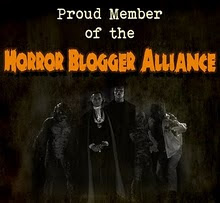
While I'm waiting for our next movie to arrive in the mail (in VHS format, gentle readers; I'm not complaining, just want you to appreciate how difficult some of these titles are to secure) I thought we could take a glance around and see how the Shock! package changed the TV landscape. As you know, Horror Incorporated didn't feature a host. But what were stations in other cities broadcasting?
There were, in fact, some very interesting things going on. Nightmare was a show out of Wichita, Kansas that starred Tom Leahy as "The Host"; it was strictly tongue in cheek. The clip below seems to be the only extant footage of the show. It's apparently from 1959, though Nightmare ran for many years after that. I do like The Host's offbeat introduction here, which gets funnier the more closely you listen to him:
Baron Daemon in Syracuse, New York strikes me as hilarious, probably because his schtick is so reminiscent of Count Floyd's on Monster Chiller Horror Theater:
Ghoulardi was a unique presence in Cleveland television in the 1960s: the clip below is from 1963, and I invite you to watch all the way to the end -- the guy would be brilliant hosting any sort of show, but he's particularly cool doing this one:
Around the same time Horror Incorporated was running here, Pittsburgh's WIIC had a lively late-night show called Chiller Theater With Chilly Billy, which featured a number of celebrity cameos. Appearing on the show was something of a ritual for visiting luminaries, apparently. In this clip Pittsburgh native Barbara Feldon shows herself to be a good sport as she clowns with host Bill Cardille.
A generation of kids in New York were freaked out by this interesting stop-motion opening for WPIX's creature-feature, also called Chiller Theater.
Elvira, Mistress of the Dark came into prominence in the mid-1980s when her L.A.-based show Elvira's Movie Macabre was syndicated nationwide. To be honest, I never cared for Elvira, partly because her jokes were dumb, but mostly because she didn't seem to have any knowledge of, or interest in, the movies she showed.
The decline of locally-produced creature features was inevitable, given the economics of TV production and distribution. But horror show hosts haven't gone away completely. Australian pay-TV channel Arena made a splash a few years ago with a host named Tabitha, who managed to get everything right -- she had a clear knowledge and affection for the movies she introduced; she could do funny while still being smart, and she could do sexy without being tasteless. To me her laid-back persona fits well with the late-late-show format, though I imagine that some might find her a bit dull:
These days, horror movie hosting has a distinctly DIY vibe to it, with independent producers finding an audience through self-syndication, web streaming, DVD releases, live appearances, internet radio and more. These are labors of love carried out by some very devoted people. Cinema Insomnia with Mr. Lobo is syndicated in some markets, (though it seems to mainly exist online) and can claim a small but loyal following. Penny Dreadful's Shilling Shockers is currently syndicated on a number of TV stations in New England. Episodes are also streamed online and available on DVD. Here's an opening from that show:
Pretty good stuff.

















